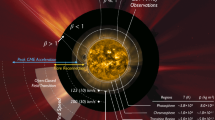Abstract
The development of principles, systems, and instruments enable the detection of exoplanets with 6–8 Earth masses or less. The launches of specialized satellites, such as CoRoT (2006) and Kepler (2009), into orbits around the Earth have enabled the discovery of new exoplanetary systems. These missions are searching for relatively low-mass planets by observing their transits over the disks of their parent stars. At the same time, supporting studies of exoplanets using ground-based facilities (that measure Keplerian components of radial velocities) are in progress. The properties of at least two objects discovered by different methods, Kepler-22 and GJ 1214b, suggested that there was another class of celestial bodies among the known types of extrasolar planets: planetans, or oceanic planets. The structure of Kepler-22 and GJ 1214b suggest that they can be these oceanic planets. In this paper, we consider to what extent this statement is valid. The consideration of exoplanet Gl 581g as an oceanic planet is more feasible. Some specific features of the physical nature of these unusual planets are presented.
Similar content being viewed by others
References
Borucki, B., 2011. http://archive.stsci.edu/kepler
Charbonneau, D., Berta, Z.K., Jonathan, J., et al., A super-Earth transiting a nearby low-mass star, Nature, 2009, vol. 462, pp. 891–894.
Endl, M., NASA’s Kepler mission and the quest for other Earthes, Proc. Workshop Extraterrestrial Life—beyond Our Expectations?, Univ. Vienna, May 21–22, 2012, p. 18.
Fei, Y., Mao, H., and Hemley, R., Thermal expansivity, bulk modulus, and melting curve of H2O ice VII to 20 GPa, J. Chem. Phys., 1993, vol. 99, no. 7, pp. 5369–5373.
Ksanfomality, L.V., Extrasolar planets as a case for possible life beyond the Earth, Proc. SPIE-2002, Int. Soc. Opt. Eng., 2002, pp. 4939–4951.
Ksanfomality, L.V., On the nature of the object HD 209458b: conclusions drawn from comparison of experimental and theoretical data, Solar Syst. Res., 2004a, vol. 38, no. 4, pp. 300–309.
Ksanfomality, L.V., Regularity of extrasolar planetary systems and the role of the star metallicity in the formation of planets (review), Solar Syst. Res., 2004b, vol. 38, no. 5, pp. 372–383.
Ksanfomality, L.V., Extrasolar low-orbit planets: dissipation of their atmospheres and probable magnetic field, Astron. Lett., 2007, vol. 33, no. 7, p. 488.
Ksanfomality, L. and Lammer, H., Water saturated atmosphere of the exoplanet GJ 1214b, Proc. European Planet. Sci. Conf.-2010 (Europlanet 2010), Roma, Sep. 2010.
Ksanfomality, L.V., Possible life discovery at the Venus, Dokl. Akad. Nauk, 2012a, vol. 246, no. 1, pp. 42–47.
Ksanfomality, L.V., Venus as a natural laboratory for search of life in high temperature conditions: events on the planet on March 1, 1982, Solar Syst. Res., 2012b, vol. 46, no. 1, pp. 41–53.
Kuchner, M.J., Volatile-rich Earth-mass planets in the habitable zone, Astrophys. J., 2003, vol. 596, pp. L105–L108.
Leger, A., Selsis, F., Sotin, C., et al., A new family of planets, Ocean-planets, Icarus, 2004, vol. 169, pp. 499–504.
Lissauer, J.L., A closely packed system of low-mass, low-density planets transiting Kepler-11, Nature, 2011, vol. 470, no. 7332, pp. 53–58.
Marcy, G., Water world larger than Earth, Nature, 2009, vol. 462, pp. 853–854.
Papaloizou, J.C.B., Nelson, R.P., Kley, W., et al., Diskplanet interactions during planet formation, in Protostars and Planets V, Tucson: Univ. Arizona Press, 2006.
Schneider, J., Planet: GL 581g, in The Extrasolar Planet Encyclopedia, 2010. http://exoplanet.eu/planet.php?=GL581g
Schneider, J., Notes for star Kepler-11, in The Extrasolar Planet Encyclopedia, 2011. http://exoplanet.eu/star.php?st=Kepler-11
Schneider, J., Planet: Kepler-22 b, in The Extrasolar Planet Encyclopedia, 2012. http://exoplanet.eu/planet.php?p1=Kepler-22&p2=b
Seager, S., Exoplanet Atmospheres: Physical Processes, Princeton: Princeton Univ. Press, 2010.
Selsis, F., Chazelas, B., Borde, P., et al., Could we identify hot ocean-planets with CoRoT, Kepler and doppler velocimetry?, Icarus, 2007, vol. 191, pp. 453–468.
Author information
Authors and Affiliations
Additional information
Original Russian Text © L.V. Ksanfomality, 2014, published in Astronomicheskii Vestnik, 2014, Vol. 48, No. 1, pp. 81–91.
Rights and permissions
About this article
Cite this article
Ksanfomality, L.V. Planetans—oceanic planets. Sol Syst Res 48, 79–89 (2014). https://doi.org/10.1134/S0038094614010055
Received:
Published:
Issue Date:
DOI: https://doi.org/10.1134/S0038094614010055




